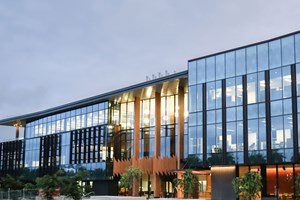Heat Strengthened Glass
Overview
Similar to the toughening process, but the glass is heated to slightly lower temperatures and has a lower cooling quench resulting in lower levels of surface compression. It does not fracture in the same fashion as toughened glass, and is not a safety glass, but it will generally break from side to side and the glass will remain in the frame after breakage.
Due to the heat strengthening process this glass is still very stable under thermal stress and is most commonly used in tinted, coated, and reflective glass where it may be partially exposed to large temperature differentials in façades vision or spandrel panels which are susceptible to large internal heat gains. There is a significantly reduced risk of spontaneous failures due to NiS.
Heat strengthened glass is often used in laminated glass, as it is generally flatter with less optical distortions than toughened glass. Because of this it is often used in curtainwall facades for both vision and spandrel glass.



